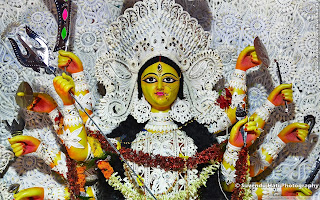Durga Puja, also called Durgotsava, is an annual Hindu festival in the Indian subcontinent that reveres the goddess Durga.It is particularly popular in West Bengal, Bihar, Jharkhand, Odisha, Assam, Tripura, Bangladesh and the diaspora from this region, and also in Nepal where it is called Dashain. The festival is observed in the Hindu calendar month of Ashvin, typically September or October of the Gregorian calendar, and is a multi-day festival that features elaborate temple and stage decorations (pandals), scripture recitation, performance arts, revelry, and processions. It is a major festival in the Shaktism tradition of Hinduism across India and Shakta Hindu diaspora.

Durga Puja festival marks the battle of goddess Durga with the shape-shifting, deceptive and powerful buffalo demon Mahishasura, and her emerging victorious. Thus, the festival epitomises the victory of good over evil, but it also is in part a harvest festival that marks the goddess as the motherly power behind all of life and creation. The Durga Puja festival dates coincide with Vijayadashami (Dussehra) observed by other traditions of Hinduism, where the Ram Lila is enacted — the victory of Rama is marked and effigies of demon Ravana are burnt instead.
The primary goddess revered during Durga Puja is Durga, but her stage and celebrations feature other major deities of Hinduism such as goddess Lakshmi (goddess of wealth, prosperity), Saraswati (goddess of knowledge and music), Ganesha (god of good beginnings) and Kartikeya (god of war). The latter two are considered to be children of Durga (Parvati). The Hindu god Shiva, as Durga's husband, is also revered during this festival. The festival begins on the first day with Mahalaya, marking Durga's advent in her battle against evil. Starting with the sixth day (Sasthi), the goddess is welcomed, festive Durga worship and celebrations begin in elaborately decorated temples and pandals hosting the statues. Lakshmi and Saraswati are revered on the following days. The festival ends of the tenth day of Vijaya Dashami, when with drum beats of music and chants, Shakta Hindu communities start a procession carrying the colorful clay statues to a river or ocean and immerse them, as a form of goodbye and her return to divine cosmos and Mount Kailash.
The festival is an old tradition of Hinduism, though it is unclear how and in which century the festival began. Surviving manuscripts from the 14th century provide guidelines for Durga puja, while historical records suggest royalty and wealthy families were sponsoring major Durga Puja public festivities since at least the 16th century.[12] The prominence of Durga Puja increased during the British Raj in its provinces of Bengal and Assam. Durga Puja is a ten-day festival, of which the last five are typically special and an annual holiday in regions such as West Bengal, Bihar, Odisha and Tripura where it is particularly popular. In the contemporary era, the importance of Durga Puja is as much as a social festival as a religious one wherever it is observed.


Durga Puja festival marks the battle of goddess Durga with the shape-shifting, deceptive and powerful buffalo demon Mahishasura, and her emerging victorious. Thus, the festival epitomises the victory of good over evil, but it also is in part a harvest festival that marks the goddess as the motherly power behind all of life and creation. The Durga Puja festival dates coincide with Vijayadashami (Dussehra) observed by other traditions of Hinduism, where the Ram Lila is enacted — the victory of Rama is marked and effigies of demon Ravana are burnt instead.
The primary goddess revered during Durga Puja is Durga, but her stage and celebrations feature other major deities of Hinduism such as goddess Lakshmi (goddess of wealth, prosperity), Saraswati (goddess of knowledge and music), Ganesha (god of good beginnings) and Kartikeya (god of war). The latter two are considered to be children of Durga (Parvati). The Hindu god Shiva, as Durga's husband, is also revered during this festival. The festival begins on the first day with Mahalaya, marking Durga's advent in her battle against evil. Starting with the sixth day (Sasthi), the goddess is welcomed, festive Durga worship and celebrations begin in elaborately decorated temples and pandals hosting the statues. Lakshmi and Saraswati are revered on the following days. The festival ends of the tenth day of Vijaya Dashami, when with drum beats of music and chants, Shakta Hindu communities start a procession carrying the colorful clay statues to a river or ocean and immerse them, as a form of goodbye and her return to divine cosmos and Mount Kailash.
The festival is an old tradition of Hinduism, though it is unclear how and in which century the festival began. Surviving manuscripts from the 14th century provide guidelines for Durga puja, while historical records suggest royalty and wealthy families were sponsoring major Durga Puja public festivities since at least the 16th century.[12] The prominence of Durga Puja increased during the British Raj in its provinces of Bengal and Assam. Durga Puja is a ten-day festival, of which the last five are typically special and an annual holiday in regions such as West Bengal, Bihar, Odisha and Tripura where it is particularly popular. In the contemporary era, the importance of Durga Puja is as much as a social festival as a religious one wherever it is observed.


Post a Comment